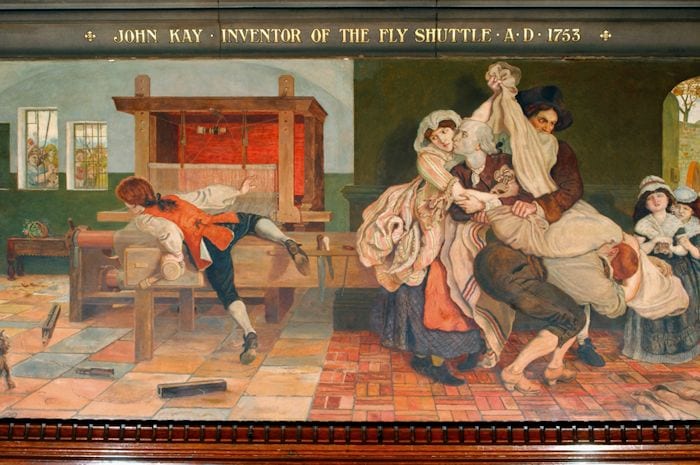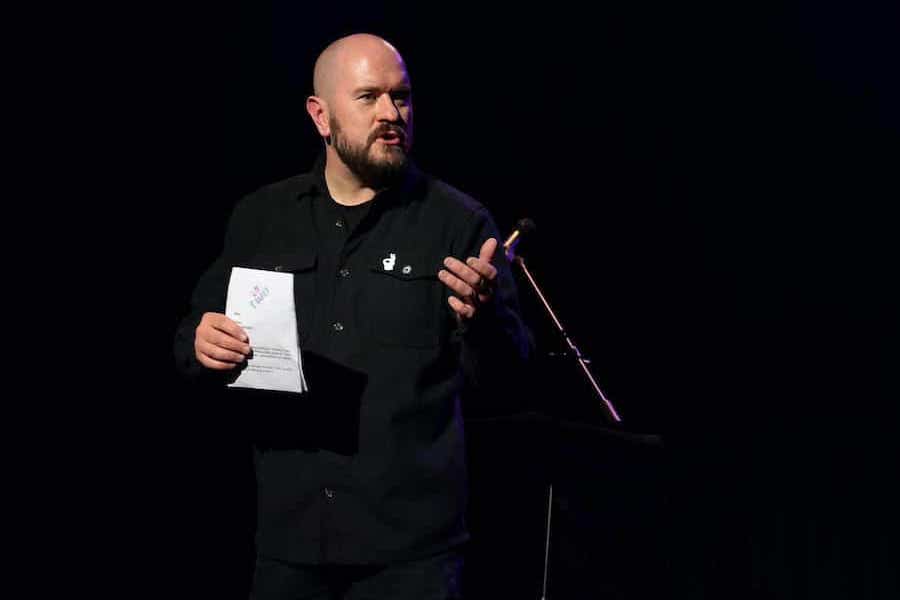The story of Manchester in 101 objects: #12 the rise of the machine age
- Written by Ed Glinert
- Last updated 5 years ago
- Culture, History

Story: The Rise of the Machine Age
Object: Kay’s Flying Shuttle
Year: 1733
Location: Town Hall Mural
In No 8, The Birth of Textiles in Manchester, we learnt that King Edward III introduced Flemish weavers to Manchester in 1363 to boost the local cloth trade. This was instrumental in the rise of Manchester as a great centre of textiles. Yet, astonishingly, for four hundred years there was no discernible improvement in the technology used.
This seems unthinkable today, when technology advances too quickly for most people to keep up with. But this was pre-Industrial Revolution.
Change came in the 18th century with a succession of ingenious inventions that revolutionised industry, not least the cotton industry. After centuries of nothing, Britain saw the following inventions:
1712 Thomas Newcomen devises an atmospheric steam engine
1733 John Kay invents the Flying Shuttle in Bury
1764 James Hargreaves creates the Spinning Jenny which could spin 8 threads at once Soon it was spinning 120 threads simultaneously
1769 James Watt (who has a statue in Piccadilly Gardens) improves the Newcomen steam engine
1769 Richard Arkwright patents the Water Frame, a machine with cogs linked to a wheel turned by running water. Two years later he opens Cromford Mill in Derbyshire. It is the first water-powered cotton spinning mill and employs 200 workers. He builds his Shudehill Mill in 1782
1779 Samuel Crompton devises the Spinning Mule which produces finer, stronger thread
1781 Boulton and Watt make a steam engine that can be used in a cotton mill
1785 Edmund Cartwright invents the power loom.
Kay’s Flying Shuttle was the first new cotton machine and so is particularly important in Manchester terms. Before Kay, textile workers had “thrown” the shuttle with their hands. This meant that at least two weavers were needed at the loom, throwing the shuttle to each other. Now, with this invention, the weavers could get through their work much more quickly by themselves.
During the 18th century, the cotton industry changed from being a home-based (cottage) industry to a large-scale factory-based industry employing thousands of workers in huge mills, some of the earliest of which survive in Ancoats.
But why did this happen in Britain? Why not Finland or Spain or Greece? The clue lies in a man whose statue resides in the reading room of the John Rylands Library: Francis Bacon, the greatest of renaissance men, philosopher, writer and politician.
In 1620, Bacon outlined his method in his book Novum Organum or “New Method”. It propounded the revolutionary idea that to understand how the world works, one should experiment, write down the findings, and conduct a better experiment next time. That simple.
This new scientific principle derided the long-held dominant view that nature could be explained by alchemy, magic, and superstition. But it took around a hundred years for society to catch up with Francis Bacon. When it did, it happened even more so in the cotton industry in Manchester.
Read how Manchester got its name here. For more information on Ed Glinert’s tours of Manchester, click here.
Did we miss something? Let us know: [email protected]
Want to be the first to receive all the latest news stories, what’s on and events from the heart of Manchester? Sign up here.
Manchester is a successful city, but there are many people that suffer. The I Love MCR Foundation helps raise vital funds to help improve the lives and prospects of people and communities across Greater Manchester – and we can’t do it without your help. So please donate or fundraise what you can because investing in your local community to help it thrive can be a massively rewarding experience. Thank you in advance!
Got a story worth sharing?
What’s the story? We are all ears when it comes to positive news and inspiring stories. You can send story ideas to [email protected]

The newly proposed skyscraper that makes Beetham Tower look small

Oldham Coliseum rescue ‘very much back on the table’

Review: Little Shop of Horrors at Octagon Theatre is a ‘fun and camp delight’

Worker Bee: Meet Hannah Beaumont-Laurencia, founder of Beaumont Organic

Worker Bee: Meet Sacha Lord, co-founder of Warehouse Project and Parklife Festival













